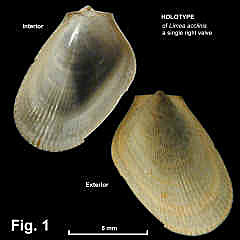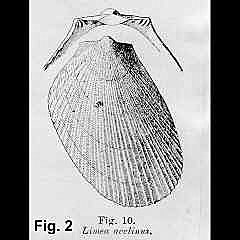|
|
LIMIDAE |
|
|
|
Escalima murrayi (E.A. Smith, 1891) Description: Shape strongly oblique. Dorsal margin straight, umbo central and elevated; anterior margin initially straight then rounded, ventral and posterior margins uniformly rounded. Hinge line straight, with prominent auricles at either end of hinge, ligament attached in triangular ligament pit above hinge line and to semicircular resilifer that projects below hinge line; 3 or 4 oblique denticles (pseudo-teeth) at either end. Interior white, corrugated by external radial ribs; margin crenulate, adductor muscle scar not apparent. Exterior with sharp, narrow, diverging radial ribs, about 40 at margin. Periostracum thin, fawn. Shell white, translucent, becoming opaque with age. Size: Up to 13 mm in height. Distribution: Tweed Heads, NSW, southwards and around southern Australia to southwestern WA. Habitat: Subtidal 66-695 m. Moderately common. Comparison: This species is characterised by the oblique denticles at the ends of the hinge line. Synonymy: Limea acclinis Hedley, 1905 is one previously recognised synonym and Escalima relegata Iredale, 1929 from South Australia is another. Remarks: This is one of the species that was first collected by the "Challenger" Expedition in 1874 at station 164B, off Sydney in 410 fathoms (750 m). However, the species from station 164B were so unfamiliar to the conchologists of the time that they concluded an error had been made, and declared that the specimens were actually from the Atlantic Ocean! This belief persisted until the 1980s, when it was debunked by the availability of more material from deep-water dredging off Sydney. The Australian Museum now holds 52 lots of this species, most of them from 300-500 m off NSW. Fig. 1: HOLOTYPE of Limea acclinis. 12.5 miles (20 km) east of Cape Byron, NSW, in 111 fathoms (203 m) (C.19808). Fig. 2: HOLOTYPE of Limea acclinis. 12.5 miles (20 km) east of Cape Byron, NSW, in 111 fathoms (203 m). Figure from original description by Hedley (1905). |
|

